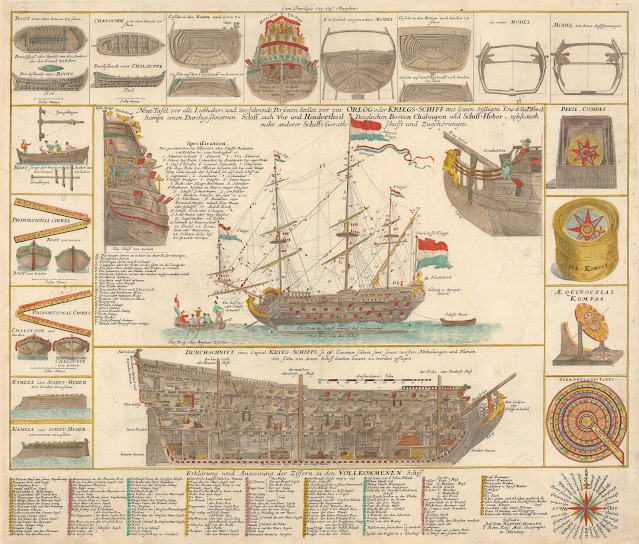click on the picture for HR viewing or go to Geographicus
This is a fascinating 1716 J. B. Homann diagram of a three-masted, 96-gun Man-o'-War - the workhorse warship of 18th-century European navies.
Such ships, also called Ships of the Line, dominated the recently-ended War of Spanish Succession (1701 - 1714), making this diagram a subject of great interest to the educated European populace.
A Closer Look :
The central images offer profile and cross-seciton views of the Man-o’-War.
The upper rendering details the ship's construction, profile, and rigging, with at least 36 types of lines named and located.
The numbers correlate to an index below the bottom border.
To the left is a rundown of a typical crew-list, naming 24 essential positions, some of whom could have multiple representatives on a large Man-o'-War.
To the left is a rundown of a typical crew-list, naming 24 essential positions, some of whom could have multiple representatives on a large Man-o'-War.
Two detailed vignettes of the bow include a proud leo-form masthead - a popular figurehead, particularly on English Ships of the Line.
Perhaps more fascinating is the cross-section dominating the lower part of the chart. Here, Homann offers insight into both the size and operation of such a vessel, naming specialized chambers dedicated to everything from bunks to cable storage to the 'Pis-Pack,' presumably a latrine.
Surrounding the main images are illustrations of escort ships, nautical instruments, and more.
Perhaps more fascinating is the cross-section dominating the lower part of the chart. Here, Homann offers insight into both the size and operation of such a vessel, naming specialized chambers dedicated to everything from bunks to cable storage to the 'Pis-Pack,' presumably a latrine.
Surrounding the main images are illustrations of escort ships, nautical instruments, and more.
Of some interest is the Kameel oder Schiff-Hever, which appears to the left of the cross-section.
This ingenious device was used to reduce the draft of large sailing ships in heavily silted harbors, particularly in the Netherlands.
Man-o’-War :
The Man-o'-War warship in the 1700s was a powerful and heavily armed naval vessel that dominated European seas during the Age of Sail.
These ships were typically equipped with multiple decks and could carry between 50 to 120 cannons, making them the backbone of the world's most powerful navies, including the British, French, and Spanish fleets.
Man-o'-War ships were designed for battle, with broadside cannons capable of devastating enemy ships during engagements.
Their size and firepower made them essential for controlling maritime trade routes, projecting naval power, and participating in large-scale naval battles, such as those during the War of Spanish Succession (1701 - 1714) and the Seven Years' War (1756 - 1763).
These ships were often crewed by hundreds of sailors and marines, and their masts could carry vast sails, allowing them to harness the wind for both maneuverability and speed.
The Man-o'-War remained a symbol of naval dominance until the advent of steam-powered ships in the 19th century, which gradually rendered them obsolete.
It was updated with his privilege at top center in a second edition in 1716.
Examples bearing the privilege, as here, are scarce, perhaps representing a small print run.

No comments:
Post a Comment